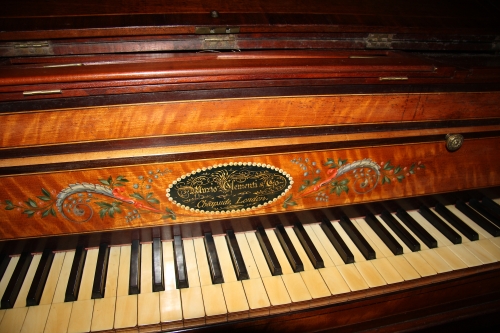Similar to Clinkscale: I.p.73,2
Restored by Bernhard Balas, Vienna Austria
Description
Nameboard: satinwood, polychrome arabesques either side of black painted cartouche inscribed “Muzio Clementi & Co./ Cheapside London” in gold
Number: 52
Compass: 5-1/2 octaves 68 notes FF-c4
Keyboard: single unreversed manual
Keyboard materials: naturals ivory, sharps ebony
Pitch: A415 Hz
Tuning: equal tempered
Action: English grand action
Hammer coverings: leather
Bridge: divided
Strings:
- Bass bridge FF – G# (16 notes) trichord brass
- Treble bridge A – C4, 52 notes trichord iron
Scale: c2 = 26.9
Dampers: cloth overdampers
Frame: timber with four metal arms to rear edge of wrestplank
Handstop: una/due corda setting at R of keyboard
Pedals: L; una corda. R; damper lift on battens mounted on front stretcher of trestle stand
Case: Sheraton style mahogany and rosewood veneer, brass reinforcement at corners(“Russian” model), two brass latches on bentside with light wood stringing
Case lid: mahogany, as for case
Keyboard lid: mahogany hinged attached to case lid
Fallboard: mahogany, as for case, attched to keyboard lid
Music desk: mahogany, detachable
Legs: four tapered square legs with brass stand casters on trestle
Dimensions(mm): 2285l x 1060w x 320h (ex lid)
Repertoire: Clementi, Field, London fortepiano school
Provenance: purchased from William Bradshaw, antique dealer, 1995
Condirion catgeory: I
Rectification required: none
Concert dates: 1.05.83, 14.07.96, 14.08.05, 02.04.17 : many programmes available
Commentary
Clementi pursued a quintuple career as composer, performer, teacher, publisher and piano maker, having in 1800 taken over the firm of Longman and expanding it; on his death in 1832, the firm continued eventually as Collard and Collard, finally ceasing operation in 1971.
Between 1802 and 1810, ????, Clementi travelled extensively in Europe often with his apprentice John Field, an equally gifted fortepianist, demonstrating his firm’s instruments. In 1802 and 1806 they visited Russia, for which lurative market Clementi designed specially strengthened instruments, so achieving a virtual monopoly.
The Russians had always preferred English fortepianos to all others, and their own instruments were imitations of these; however, these tended to dry out, become unglued and fall apart in the superheated Russian interiors. Clementi’s “Russian” grands were especially reinforced with external brass corners to combat this contingency; such an instrument was supplied to the composer Glinka, and another.
The present instrument, the second oldest of six surviving 5 1/2 octave Clementi grands and the only extant “Russian model”, became in 1810 the property of the British ambassador to St. Petersburg, who fled with all his goods and chattels at the time of the Napoleonic invasion. From that time (1812) until a few years ago, it reposed forgotten in an attic in the family manor house in Ireland, and was there discovered by well-known dealer and collector, Mr. William Bradshaw.
It is tempting to imagine Clementi standing by while his apprentice John Field demonstrated this beautiful grand to His Excellency.


Leave a comment